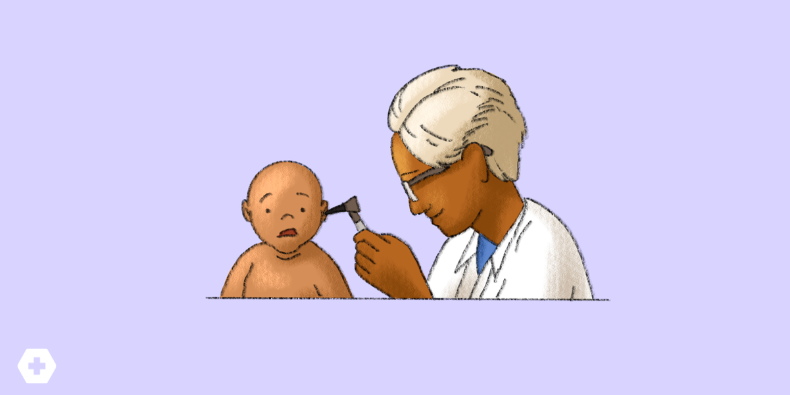
Understanding Otitis Media Symptoms and Treatment in Kids

Ah, otitis media—the classic ear infection in the middle ear. It may be a bread and butter diagnosis in the pediatric clinic, but its management can be nuanced. Do you treat it now or wait it out? What’s the go-to antibiotic? And when is it time to loop in the ENT? Let’s cut through the noise with a back-to-basics review, plus a few pearls that might just change your approach.
What Is Otitis Media, Really?
Otitis media (OM) is a spectrum and includes several different diagnoses.
- ▪️Otitis media with effusion (OME): fluid in the middle ear without signs of infection, possibly from eustachian tube dysfunction
- ▪️Acute otitis media (AOM): signs of inflammation in the middle ear, commonly caused by infection
- ▪️Chronic otitis media with effusion: inflammation from fluid trapped in the middle ear ≥ 3 months
- ▪️Chronic suppurative otitis media with effusion (CSOM): chronic inflammation in the middle ear with a non-intact tympanic membrane (TM) + persistent ear drainage
Risk factors for otitis media include young age, male sex, daycare attendance, exposure to tobacco smoke, immunodeficiency and presence of craniofacial anomaly (such as cleft palate). Having been breastfed is protective against the development of OM.
Otitis Media Symptoms and Diagnosis
Clinical diagnosis hinges on classic ear infection symptoms, as well as visualization of the TM. Otitis media symptoms may include ear pain, fever, hearing difficulty, and sometimes otorrhea. Infants may have more nonspecific symptoms such as fussiness and poor feeding. When it comes to the physical exam, remember that an erythematous TM alone is not enough to make a diagnosis! The following findings will help you narrow it down:
- ▪️AOM: symptoms of acute inflammation (ear pain) + dull, bulging TM
- ▪️OME: visible air-fluid level behind TM or reduced TM mobility, without evidence of acute inflammation/infection
Pain Control and Antibiotics
Pain management matters—regardless of whether you’re prescribing antibiotics. Acetaminophen and ibuprofen continue to be our mainstays for pain management.
Does the child need antibiotic therapy? That depends. Here’s a simplified breakdown of who should get antibiotics for AOM:
-
▪️Children < 6 months old, or those who are immunocompromised, with unilateral or bilateral AOM
-
▪️Children ≥ 6 months old with unilateral or bilateral AOM + severe symptoms (moderate to severe pain, pain for ≥ 48 hours, temperature ≥ 39°C)
-
▪️Children < 24 months with bilateral AOM without severe symptoms
-
▪️Children of any age with otorrhea (unilateral or bilateral)
Close observation with follow-up is appropriate for children 6-23 months old with unilateral AOM and children ≥ 24 months old with bilateral or unilateral AOM as long as no severe symptoms are present.
Antibiotic Selection
High-dose amoxicillin (90 mg/kg/day) is first-line unless there’s a specific concern for beta-lactamase producers like in AOM with purulent conjunctivitis (think nontypeable Haemophilus influenzae), where amoxicillin-clavulanate should be used.
For penicillin allergies:
- ▪️Use cefdinir if the allergy is non-IgE-mediated
- ▪️Go with azithromycin or clarithromycin for IgE-mediated allergies, but remember, macrolides aren’t great against Haemophilus influenza
- ▪️Ceftriaxone IM is an option for vomiting kids or treatment failures
Duration of treatment matters, too: 10 days for kids < 2 years old or with TM perforation, 5-7 days for kids ≥ 2 years with no history of recurrent AOM.
It is also important to keep in mind that kids with otorrhea that have ear tubes may be treated with fluoroquinolone otic drops +/- corticosteroids.
When to Refer to ENT
Referral to ENT to discuss tympanostomy tube insertion may be indicated when a child has had:
- ▪️≥ 3 distinct episodes of AOM
- ▪️≥ 4 distinct episodes of AOM within 12 months, with 1 episode in preceding 6 months
Kids with other signs of complications such as persistent otorrhea or hearing loss should also be referred for further evaluation.
Want more practical tips for your pediatric practice? Tune in to our Peds RAP segment, "New insights into Acute Otitis Media: how has the pneumococcal vaccine changed the landscape?"
Practice-Changing Education
Experience education that goes beyond theory. Explore Hippo Education’s offerings below.

